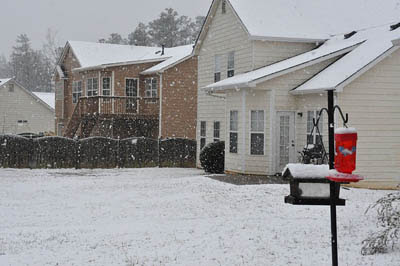Last Updated on January 26, 2024 by Greg Gillson
Ever thought about having two bird feeders in your backyard – one for the tiny, colorful hummingbirds and another for the more common birds?
Well, we’re here to answer a simple question: Can you put a hummingbird feeder next to a bird feeder?
Let’s break it down and find out if these two feeders can share the same space and attract a variety of feathered friends to your garden.

Can You Put a Hummingbird Feeder Next to a Bird Feeder?
Yes, you can definitely put a hummingbird feeder next to a bird feeder.
In fact, doing so can create a lively and diverse birdwatching environment in your backyard.
Hummingbirds, with their vibrant plumage and aerial acrobatics, offer a striking contrast to the more common garden birds that visit standard feeders.
This combination not only adds visual interest but also broadens the range of species you can observe.
Moreover, it promotes biodiversity by attracting a variety of birds to your garden, contributing to a healthier local ecosystem.
Additionally, it’s worth noting that sometimes active birds at the seed feeder can startle hummingbirds.
To promote a more harmonious feeding environment, consider placing the feeders 4 – 6 feet apart.
This spacing allows birds to access both feeders simultaneously, ensuring that all your feathered friends can enjoy their meals without disruptions.
Things to Consider When Placing these Feeders Together
1. Spacing and Placement
Place the feeders at a distance that allows different bird species to access them comfortably.
Hummingbird feeders should be positioned slightly higher than bird feeders, as hummingbirds are more agile and prefer to feed in mid-air.
This arrangement prevents territorial conflicts between birds.
The recommended distance is 4 – 6 feet apart.
2. Food Types
Use the appropriate food for each feeder.
Hummingbirds are primarily attracted to nectar, while other birds enjoy seeds, suet, or insects.
3. Feeder Design
Consider the design of the feeders.
Hummingbird feeders often have small, specialized ports for their long beaks, while bird feeders may have perches or trays.
Make sure the feeders are designed to accommodate the specific needs of the birds you wish to attract.
 |
| Rufous Hummingbird. Greg Gillson |
4. Maintenance
Cleaning should be done every few days in warm weather and less frequently in cooler seasons.
So go ahead, set up your hummingbird feeder next to your bird feeder, and get ready for a symphony of colors and songs right in your own backyard.
Regularly clean and refill both feeders.
Cleanliness is crucial to prevent the growth of mold, bacteria, and diseases that can harm the birds.
5. Predator Protection
Ensure that the feeders are placed in a location that minimizes the risk of predation.
Keep them away from areas where cats or other predators can easily ambush visiting birds.
Providing some natural cover nearby, like shrubs or trees, can also help birds feel safer while feeding.
6. Visibility
Position the feeders in a spot where you can easily observe and enjoy the birds.
Consider placing them near a window or a seating area in your garden to enhance your birdwatching experience.
By carefully considering these factors, you can create a harmonious feeding station that attracts a variety of bird species while ensuring their safety and well-being.

Wrapping Up
In the world of backyard birdwatching, the answer to the question, “Can you put a hummingbird feeder next to a bird feeder?” is a resounding “Yes!”.
By following some simple guidelines and considering the needs of both hummingbirds and other bird species, you can create a harmonious feeding station that will delight both you and your feathered friends.
Remember the importance of proper spacing, choosing the right food for each feeder, and maintaining cleanliness.
By doing so, you’ll be providing a safe and inviting haven for a diverse array of birds to visit and enjoy.
So go ahead, set up your hummingbird feeder next to your bird feeder, and get ready for a symphony of colors and songs right in your own backyard.
Whether you’re mesmerized by the agile acrobatics of hummingbirds or the melodious chirping of sparrows, the coexistence of these feeders will enrich your birdwatching experience and bring you closer to the fascinating world of avian wonders.
Happy birdwatching!

Frequently Asked Questions
Can hummingbirds and other birds share the same feeding space?
Yes, they can! With the right setup and considerations, hummingbirds and other birds can coexist peacefully at the same feeding station.
How should I space the feeders to avoid conflicts?
Place the hummingbird feeder slightly higher than the bird feeder, ensuring there’s enough vertical space between them. This helps prevent territorial disputes.
What kind of food should I use for a hummingbird feeder?
Hummingbirds are attracted to nectar, which you can make using a simple sugar-water solution (1 part sugar to 4 parts water). Avoid using honey, as it can be harmful to them.
What food is best for a bird feeder?
The food you use depends on the birds you want to attract. Common options include seeds, suet, mealworms, or a blend of these. Different bird species have varying preferences.
Will the presence of hummingbirds deter other birds from visiting the feeders?
In most cases, hummingbirds won’t deter other birds. However, providing enough feeding opportunities and space can prevent competition.
Can I attract specific bird species with certain feeder designs?
Yes, you can. Different feeder designs cater to specific birds. For example, tube feeders are great for finches, while suet feeders attract woodpeckers. Choose feeders based on your target species.
Related Articles:











